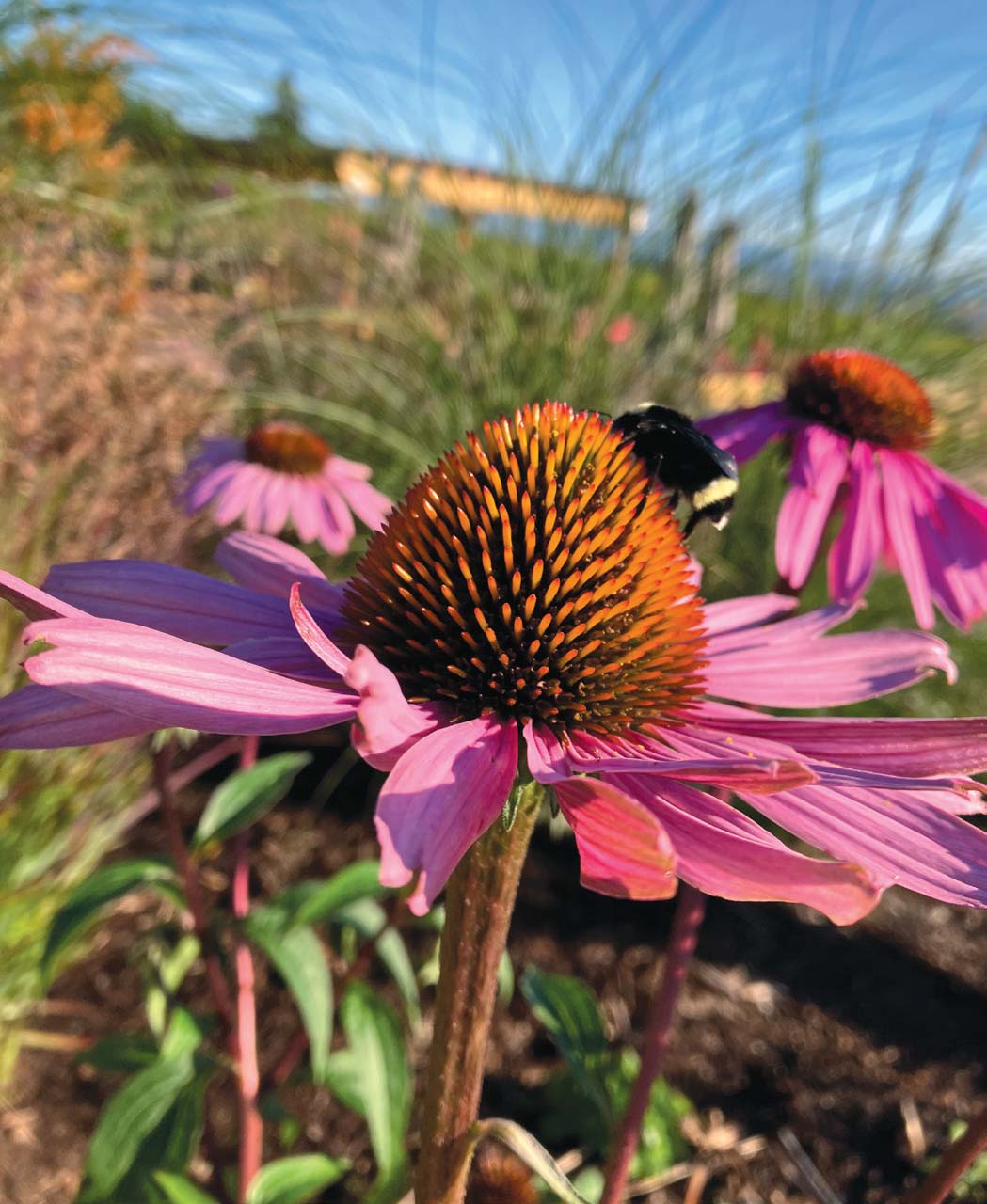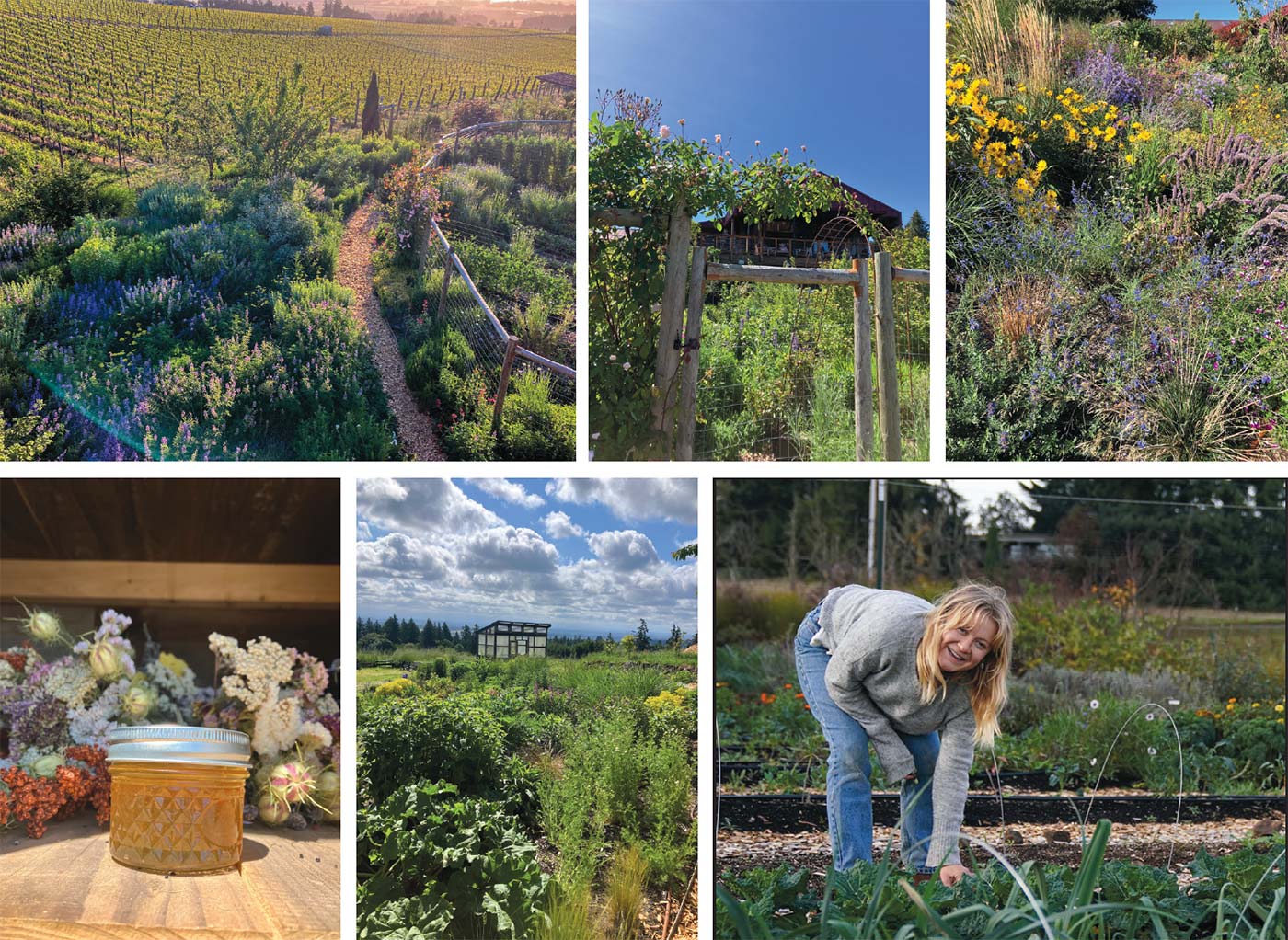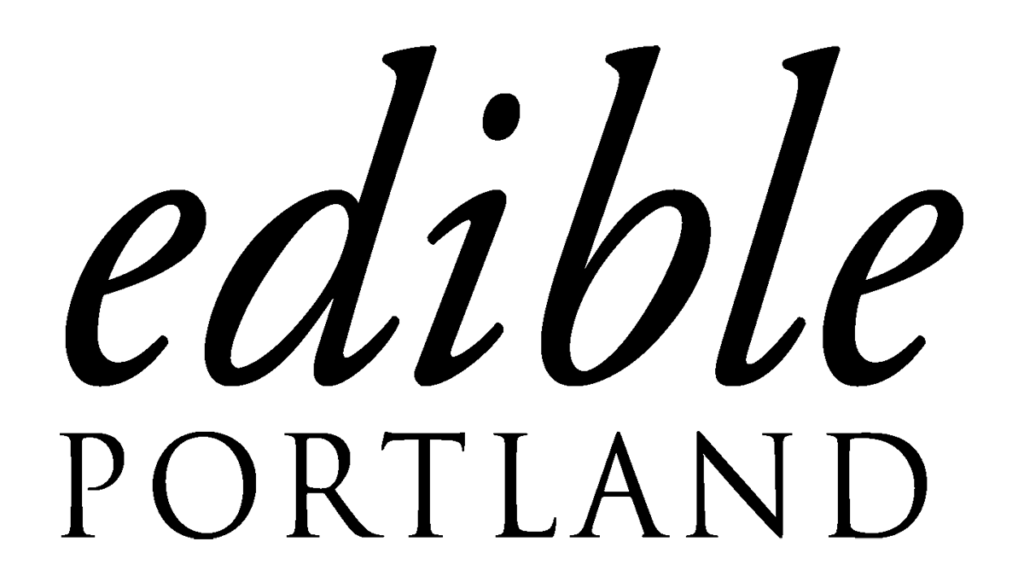
Get inspired by pollinators this summer with native plant gardens, bee-friendly wineries and buzz-worthy books.
“If we want food, we need pollinators,” says Emily Gladhardt as she walks through wispy goldenrod and showy milkweed. At Winter’s Hill Estate, a family-run winery in Dundee, that means farming and gardening with pollinators and birds in mind.
When Gladhart tours guests around the family’s 150-acre estate — that includes thirty-five acres of vineyards along with oak savanna and fir forests — she explains her strategy is ensuring there’s a stretch of plants and hedgerows providing nectar for insects and birds from early spring until late fall. “You have to always think about the various plants’ bloom cycle.”
Some of the early-blooming shrubs she relies on include red currant bushes, the fast-growing osoberry, and the Oregon grape. In mid-summer, she has cheery California poppy blooming along with bell-shaped foxglove. Other native plants she grows include pearly everlasting, trillium, fleabane, yarrow, and cinquefoil.
“What I like about pollinators is they add one more level of intrigue,” says Gladhardt. “I enjoy the soil texture, the greens and colors of the plants and the pollinators. I love being reminded by the pollinators that we are all connected and interdependent.”
In addition to dedicating plots for pollinator gardens, Winter’s Hill was an early supporter of the Oregon Bee Project, acting as a bee collection site for the Oregon Bee Atlas, which is an ongoing project to map out Oregon’s estimated 700 different species of bees. Now wineries, farms and citizen scientists across the state have joined the effort.
OREGON BEE ATLAS AND BUILDING BIODIVERSITY
“We have around 175,000 bee-plant interaction records, and volunteers are out again this year collecting data,” says Andony Melathopoulos, an assistant professor of pollinator health at Oregon State University. The bee-plant interaction is recorded with iNaturalist, a biodiversity app you add to your phone.
At Brooks Winery in Amity, stewardship coordinator Shannon Mayhew takes photos using the app every month of plants in various bloom cycles. “iNaturalist stores those photos and compiles all the data at the end of the year by location and then analyzes what plants you can add that would benefit different pollinators, like the native leafcutter bee,” she says. “Because bees all have different pollen needs, which helps you fill in those gaps.”
As Melathopoulos explains, it takes a village. The data collected outside of vineyards is used to inform their team about what plants in a region attract rare and interesting bees. “We then let vineyard managers know those plants in order to maximize bee biodiversity on their sites.”
In addition to a garden dedicated to biodynamic preps (including yarrow, nettle and valerian), Mayhew manages a robust market and berry garden, a lateseason meadow oasis and a series of hedgerows that serve as habitat corridors so insects can move throughout the property. She also recently built a pond and surrounded it with native plants to bring in and support more wildlife. “There are tons of dragonflies and tree swallows darting around that swoop in the evening,” she says. “And our first frog moved in — we named him Basil.”
One of the frequent topics that comes up when talking with winery participants about farming or gardening for pollinators is that it’s an easy way to make a big impact. “There’s this feeling of well-being when you’re in a space where bees are pollinating right next to the favas you are growing,” says Mayhew. “It’s uplifting to know you’re doing something that is intrinsically helpful.”

EXPLORE THE WILLAMETTE VALLEY’S BEE-FRIENDLY WINE TRAIL
This summer, you can explore the state’s bee-friendly wine trail, offi cially launched with over 20 wineries offering educational activities, guided tours and tastings. Upcoming events include a bee safari at Winter’s Hill Estate with Gladhardt on July 27th, a guided hike at Soter Vineyards on August 10th, a garden tour that will highlight late-season pollinator plants at Brooks Wine on September 7th, and an orchard walk at Stoller Family Estate on September 29th.
All of the bee-friendly gatherings will include a chance to chat with a guest melittologist or resident beekeeper to learn more about beekeeping, mason bees, bee biodiversity and planting for bees in your own garden. You can also take your own tour along the bee-friendly trail by visiting other participating wineries, including Abbot Claim, Abbey Road Farm, Domaine Willamette, Fairsing Vineyard, Left Coast Estate, Lumos Wine Co., Montinore Estate, Remy Wines, Sokol Blosser, Willamette Valley Vineyards and Youngberg Hill Inn & Winery. For information on the tours and wineries, visit oregonbeeproject.org/winetour.
BUZZ-WORTHY BOOKS AND RESOURCES
To dive deeper into the wild and wonderful world of bees, check out courses and programs offered by organizations around the city, from Portland Metro Beekeepers to Bridgetown Bees. Or go back to school with Oregon State University’s Master Beekeeper Program, which includes experiential learning and certifi cates at three successive levels. In the summer months, the program hosts “Friday in the Apiary,” an informal bee-focused happy hour where the buzz centers around best practices in beekeeping and hive management.
Many local nurseries offer seasonal workshops for creating pollinator-friendly gardens with native plants — and the online resources for Portland Nursery and Cornell Farm are particularly robust. For DIY gardeners, check out The Pacifi c Northwest Native Plant Primer, a recently published tome packed with beautiful photos and tips for sustainable landscaping authored by the founders of Humble Roots Farm & Nursery in Mosier. Or escape into the moving world created by local author (and beekeeper) Eileen Garvin with The Music of Bees, her debut novel set in Hood River.

